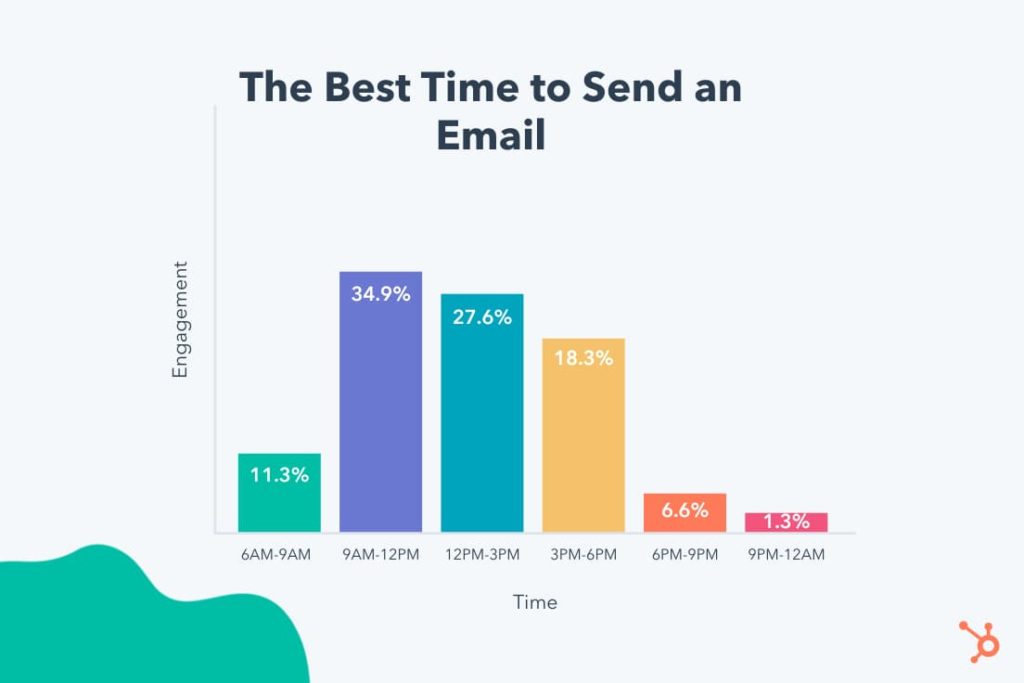Are you aware that if you don’t know the best time to send emails to your customers, no catchy subject line will save your campaigns?
Some business owners realize that subject lines and a to-the-point body are essential for the success of their email marketing. But not all of them remember that WHEN you contact your customers is as important as HOW you do it.
If you’re here, it means you’re not one of them and you want to discover the best time to send emails included in your campaigns.
And we’ve got the answers you need, so let’s get to it.
Why Does Optimizing Sending Times Matter?
Before we begin, let’s tackle the basics. It’s important to understand why exactly you need to know the best time to send emails to your clients. This will help you set the goals to reach and KPIs to measure – criteria without which you can’t define your success.
Don’t Get Ignored
One of the simplest reasons to focus on the best time to send emails is to avoid getting ignored.
There’s little more to it. If your emails reach your customers at inconvenient times, they will, in the best case, only glance over them.
Most often, however, they won’t be even around their mailbox to see that you’re trying to get in touch.
The bottom line is that emails sent at the wrong times don’t get noticed. And even if they do, they’re not opened or responded to.
This is something you’ll want to avoid to not waste your efforts.
Get Higher Engagement
If you know what’s the best time to send emails to your customers and utilize this knowledge, you reap higher engagement.
Messages received when the time is right are opened and read more often. Furthermore, they stand out with a higher click-through rate, directing more traffic to your landing pages.
Reach People When They’re Ready to Do Business With You
It’s a bit like visiting someone at their home when they’re not ready for guests. If you send emails at the wrong times, there’s a very little chance people will consider your offer.
That’s why the best time to send emails is when they’re ready to do business with you. Consider when they’re likely to be free (or least occupied) and have enough time to think about your proposal.
 Source: Hubspot
Source: Hubspot
Benefits of Well-Timed Email Campaigns
Let’s translate all of this into tangible benefits of knowing what’s the best time to send emails to your customers. Yes, you can measure whether the time is right – and here are some KPIs to look at.
Higher Open Rate
Well-timed emails stand out with higher open rates. It’s in the name – if the time is right, your emails will be read more often. More people will see your message and become potential follow-up targets.
Higher Click-Through Rates
Another KPI to look at is click-through rate. If you send your emails at the best time possible, the CTR is likely to be much higher. While this also depends on your messaging, remember that no link will get clicked if people don’t have time for it.
Higher Conversions
Similarly to the KPIs above, your conversions will be higher if your emails are well-timed. If you nail the moment when your customers have time and energy, they’ll be much more likely to consider a purchase. Ultimately, that’s your goal – and that’s why timing your emails matters so much.
Things to Consider When Sending Emails
As you’ll see soon enough, there are studies investigating the best time to send emails. However, no matter what benchmarks you follow, there are a few factors to keep in mind. They are specific to you and your business, and they will affect your own best times to contact your customers.
The Platform You’re Using For Email Marketing
Using email marketing platforms is the most common way to put your message in your customers’ mailbox. But it’s not the only one. There are plenty of other ways to release newsletters and do cold outreach (for example, LinkedIn messaging).
Making use of such third-party platforms may affect your open and click-through rates. Your customers may have time to check their mailbox, but you can’t predict when they’ll hang out in those “other” places that they get emails from.
Working Hours of Your Customers
It will be easier if your customers are 9-7 office employees. But, if you’re targeting those who are in the field or work irregular hours, you’ll need to determine what’s the best time to contact them.
Previous Experiments
Your own experience is usually the best data. No average benchmarks will be useful if you see they don’t match your audience. Pay attention to what’s going on. If you notice that your customers do enjoy emails on Sunday evenings – then yes, that’s the right time to get in touch with them.
The Best Time to Send Emails To Your Customers
Now that we tackled the essentials, let’s take a look at a few studies on the subject. These can become an excellent starting point for your own tweaks and experiments with sending times.
According to Hubspot, the best time to send emails is between 9 AM to 12 PM and 12 PM to 3 PM.
They have also asked which day of the week is best for email marketing campaigns. Apparently, “22.6% of U.S. marketers said Monday, 24.9% said Tuesday, and 21.3% of U.S. marketers said Wednesday.”
OptinMonster agrees, partially at least, that Tuesday is the best time to send emails. They also recommend Thursday as the second-best option. Their own research showed that there is “no consensus on the exact day or time to send emails”. However, they do recommend 8 AM and 1 PM as some of the best moments – right after people arrive at work, and when they leave for the lunch break.
Lastly, Co-Schedule also stands behind Tuesday as the best time to send emails. While they pinpoint a few times throughout the day, they seem to agree that emails sent in the late morning (around 10 AM) are performing best.
Final Thoughts
Even with the data available, it might be hard to find the best time to send emails to your customers.
All the studies are a good starting point – but be sure to experiment on your own and measure your KPIs.
This way, you’ll find what fits your business strategy, moves the needle for your business and is best for your customers.
